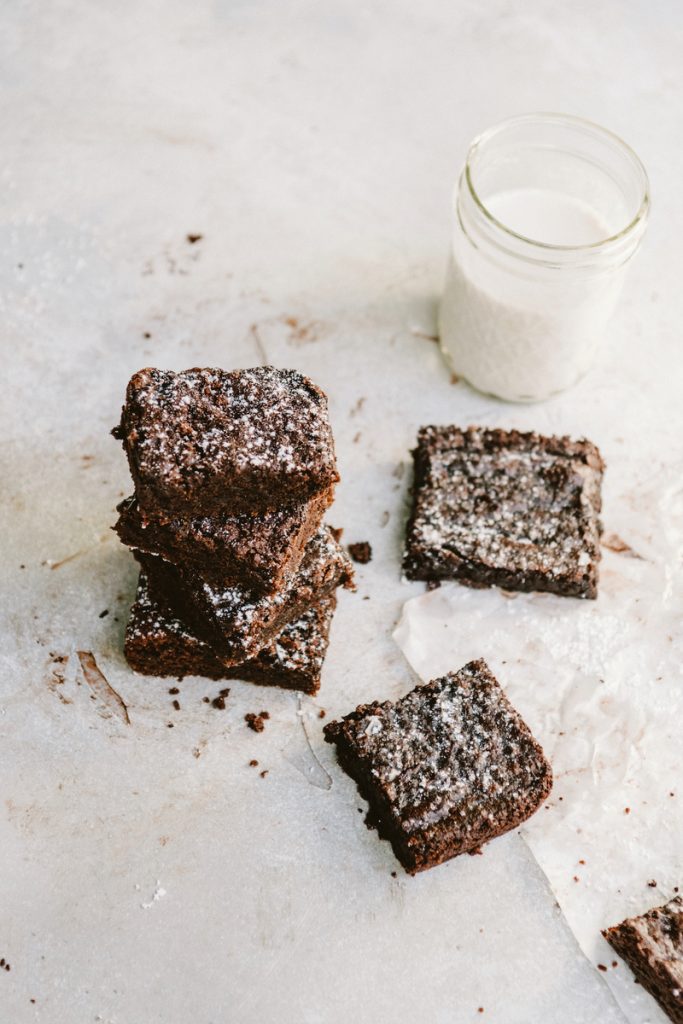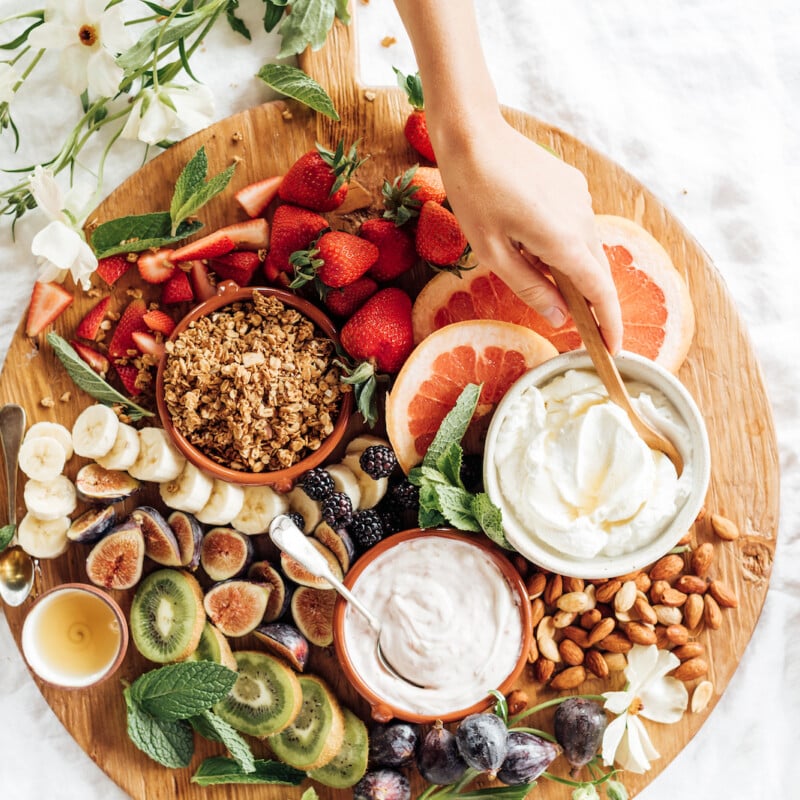We’re more than halfway through 2022 (wild!), which means it’s time to check in and get a pulse on your well-being. Did you set health goals at the beginning of the year? Maybe you vowed to eat more healthfully. Or at the very least, eat more mindfully. Perhaps you committed to eat more meals at home and less takeout. After all, nothing’s more nutritious and budget-friendly. Whether you’re meeting your wellness goals—or need some motivation—a spoonful of seeds a day keeps the doctor away. Specifically, flaxseeds. In the spirit of up-leveling your health, we’re diving into the benefits of flaxseeds, how to eat them, and why they’re considered a superfood.
Featured image by Michelle Nash.



What Are Flaxseeds?
Long before flaxseed was the superseed we know it as today, it had a variety of uses. Think: flax linen (its fibers are 2-3x as strong as cotton!) and textiles. These days, it’s considered a staple in the nutrition world. It’s known for being an excellent source of healthy omega-3 fatty acids and fiber. Typically harvested in August, flaxseed comes from the flax plant. It’s cultivated all over the world, and its nutty-tasting seeds can be eaten whole, ground, or cold-pressed to release flaxseed oil.
For decades, you’d find flaxseed in products like bread and cereals. But more recently, it’s developed a niche in the health food scene. Of its many uses, flax can be turned into a vegan egg when baking, sprinkled on yogurt parfaits, and added to energy bites. Beyond culinary uses, it’s also a fantastic supplement to reduce inflammation.


Whole vs. Ground Flaxseeds
If you’ve ever shopped for flaxseeds, you’ve probably seen both at the store: whole and ground. You’ll also find flaxseed oil. Whole flaxseeds are difficult to crack, even with careful chewing. And if the flaxseed passes through the digestive tract unbroken, the body does not receive the full nutritional benefits. Grinding breaks up the seed, making it easier for the body to digest. Therefore, ground flaxseed (also known as flax meal) provides more nutritional benefits than whole flaxseed.
For More Nutrition, Grind Your Flaxseeds At Home
You might be wondering, why go through the (minimal) effort of grinding your seeds at home? Experts agree that you get a better bang for your nutritional buck. While store-bought ground flaxseeds offer similar amounts of protein, total fat, fiber, etc. as those you grind yourself, pre-ground flaxseeds contain lower levels of heart-healthy fats. Reason being, when you buy flaxseed that’s already been ground, it’s been exposed to oxygen longer. Oxygen causes polyunsaturated fats to break down (so do heat and light).


How To Grind Whole Flaxseeds
Given that ground flaxseed is more optimal, let’s talk about how to grind flaxseeds at home. It’s easy! And you have options.
Via a blender or food processor.
You can use a blender or food processor to grind flax seeds. To grind flaxseeds with a blender, add 1 cup of whole flaxseeds to your appliance and blend (or process) for a few minutes—or until the flax is ground to your desired consistency.
Use a coffee grinder.
In my opinion, this is the easiest, most convenient way to grind flax seeds. Coffee grinders are quick and efficient. Add whole seeds up to the fill level of a coffee grinder that you specifically use for flax seeds and power it on. It should only take a few seconds for the seeds to be fully ground. Additionally, using a coffee grinder allows you to only grind the amount you need.
The Best Way To Store Flaxseeds
Whether you buy your flaxseeds whole or ground, it’s best to store them in the fridge or freezer. Just as storing nuts this way extends their shelf life, the same goes for flaxseeds (and flaxseed meal). In fact, they can last up to one year in the fridge and freezer. If your flaxseeds have an “off” smell or flavor, they likely went rancid. Best to compost or toss them.
More on nut and seed storage tips, here!


Can I eat flaxseeds every day?
Yes! While there is no specific recommendation for flaxseed intake, 1-2 tablespoons a day is considered a healthy amount. With their slightly nutty taste, they bode well in many recipes. One of my favorite ways to consume ground flax is via seed cycling. This practice helps naturally balance hormones while increasing your intake of four different types of seeds. Like any high-fiber food, flax can make you feel a bit bloated. I suggest starting with a teaspoon a day and working your way up to two tablespoons.
Before adding flaxseed to your diet, talk to your healthcare practitioner if you have kidney disease, hormone-related cancers, or diverticulitis.
How To Eat Flaxseeds
Flax has a mild, nutty flavor. When mixed into other foods, you can hardly taste it! A few ideas for incorporating flax:
- Sprinkle flax on dairy or non-dairy yogurt, cottage cheese, or oatmeal.
- Add a spoonful to your favorite salad.
- Stir flaxseed into sauces or soups.
- Scoop flax into smoothies.
- Add flax to baked goods, such as muffins or pancakes.
- Use flax as a flour substitute: swap up to 3/4 cup of the flour in the recipe for flax.
- Replace an egg. For a plant-based egg substitute, mix one tablespoon of flax with three tablespoons of water. Let it sit until it forms a gel. Use it in recipes, like this, in place of eggs.


6 Benefits of Flaxseeds
Last but not least, let’s dive into six benefits of flaxseeds.
- Improve digestion. Flaxseed can help with digestive issues like constipation, thanks to its high-fiber content. Flax contains both soluble and insoluble fiber, a win-win. Ground flaxseed aids in satiation while keeping food moving smoothly through the digestive tract.
- Lower cholesterol levels. Flaxseed is linked to lowering levels of low-density lipoprotein (LDL, or “bad”) cholesterol, which means it can help prevent other health issues such as heart disease and stroke. As a whole, flaxseed is rich in ALA, a type of omega-3 fatty acid, that is known to support overall heart health.
- Aid in weight management. Mainly, this is because of its soluble fiber, which slows digestion and increases feelings of fullness. In fact, a large review of 45 studies found that supplementing with flaxseed resulted in significant reductions in body weight, BMI, and belly fat.
- Support insulin sensitivity. Insulin resistance—or an inability to effectively use the hormone insulin—is the hallmark of type 2 diabetes. Some research suggests that flaxseed oil can help improve insulin sensitivity.
- Balance hormones. Do you struggle with PMS or are you estrogen dominant? If so, ground flax is remarkably helpful. Flax is known to help balance hormones, hence why it’s included in the practice of monthly seed cycling. Basically, its insoluble fibers help bind to estrogen, shuttling them out of the body. This helps reduce or prevent those “estrogen dominant” symptoms.
- Boost skin and hair health. The essential fatty acids in flaxseed oil are known to keep skin moisturized and hydrated. With that comes a reduction in the appearance of wrinkles and other aging signs. This multitasking, anti-inflammatory oil can be applied to skin to soothe irritations or soften roughness.





